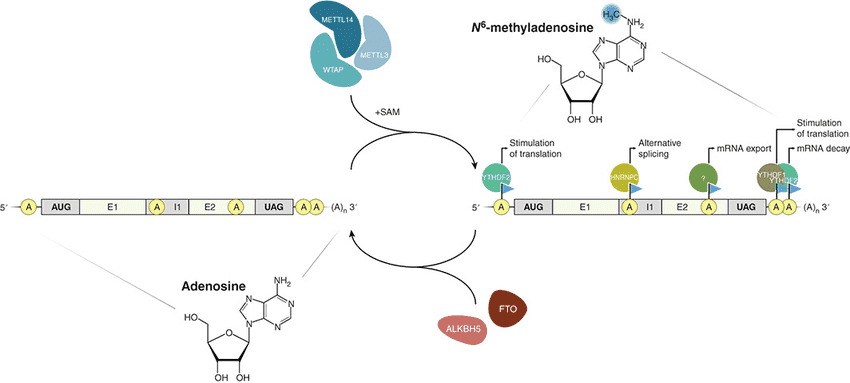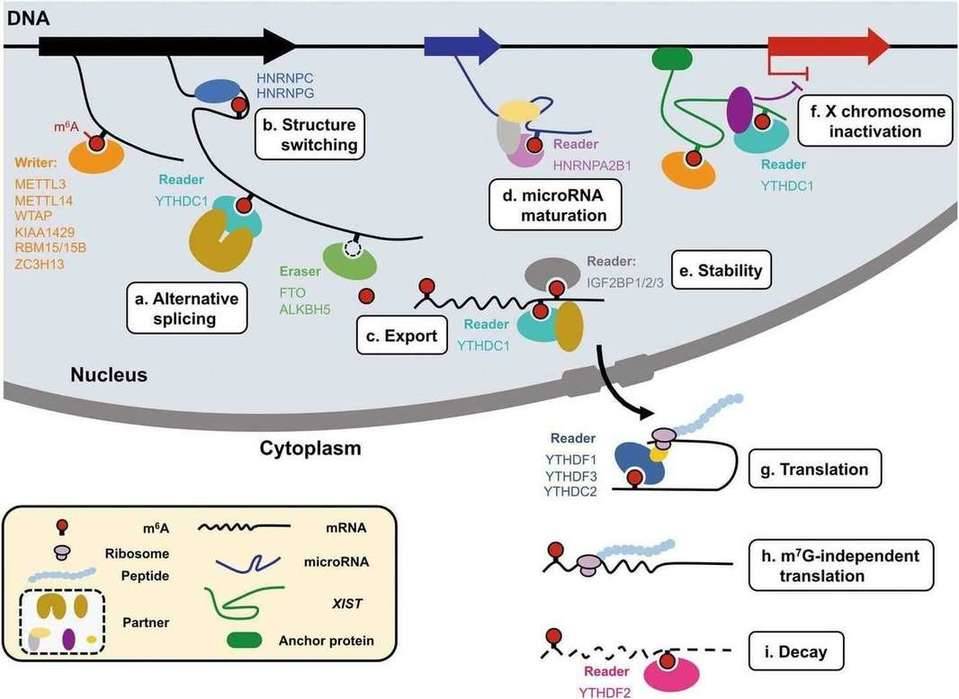The RNA modification was thought to be the minor chemical changes of nucleic acid structure in RNA (such as rRNA, tRNA, and snoRNA) during post-synthesis. With the development of sequencing technologies and the accumulated knowledge on RNA modification, researchers have found that RNA modifications, the reversible and dynamic epigenetic modifications, are ubiquitous at the transcriptomic level. RNA modification involves in all aspects of biological processes, including but not limited to cell differentiation decision, sex decision, and stress response.
m6A (N6-Methyladenosine) modification, an abundant modification in RNA (both mRNA and ncRNA) and DNA, is highly conserved among different species. It is widely studied and has been confirmed to exist in some viruses and most eukaryotes including mammals, insects, plants, and yeast. It is conservatively estimated that over 12,000 m6A modification sites exist in 7000 human genes, playing a key role in regulating gene expression, concerning stem cell pluripotency and somatic cell reprogramming, sex determination, UV-induced DNA damage stress, spermatogenesis, T cell homeostasis, central neurogenesis and neuroelectricity. In addition, m6A may also involve in pathogenesis, and the linkages between m6A and numerous diseases have been indicated in scientific reports.
 Figure 1. The dynamics of the m6A methylome (Hoernes 2016)
Figure 1. The dynamics of the m6A methylome (Hoernes 2016)
Coupled with high-throughput sequencing, methylated RNA immunoprecipitation sequencing (MeRIP-Seq) concentrates hypermethylated RNA fragments with N6-methyladenine antibodies and interprets the methylation distribution, function, and related characteristics of m6A within the full transcriptome. It analyses the differences of RNA methylation modification patterns among different cells, tissues, and other samples, and helps to solve biological problems such as cell differentiation, biological development, disease occurrence and development, and so on.
 Figure 2. Diverse molecular functions of m6A (Yang 2018)
Figure 2. Diverse molecular functions of m6A (Yang 2018)
Regulation of Gene Expression
The interaction between m6A and ncRNA is one of the research hotspots. The most widely studied ncRNAs include microRNA (miRNA), lncRNA, and circRNA. For instance, METTL3 takes effect by regulating pri-miRNA recognition;
the m6A modification in the stem ring structure of lncRNA MALAT1 is involved in regulating pre-mRNA synthesis; the m6A modification in circRNA is involved in protein coding; ALKBH5-related m6A modification in lncRNA FOXM1-AS regulates the proliferation of cancer cells…
Biological Function Regulation
It has been found that m6A plays an important role in gender determination, maternal mRNA clearance, spermatogenesis, neural development and other biological functions. For example, mRNA and histone modification interact to regulate neural stem cells self-renewal and differentiation, which may lead to the development of stem cell therapy and gene-targeted therapies for neurological diseases.
Regulation of Virus Replication
m6A modifications are important in the development of diseases, especially those caused by pathogenic viruses. The m6A modifications regulate the expression of virus-related genes, thereby affecting virus replication and infection. For some viruses, the viral RNA is modified by m6A to varying degrees. And the m6A modifications play different roles in pathogenesis for different types of viruses. Therefore, studying the biological function of m6A in different viruses is of great significance to understand the pathogenic mechanism of the viruses.
Modification Abnormalities and Diseases
The change of m6A expression level is involved in the pathological process of many diseases. Researchers have studied the effect targets and regulatory roles of m6A in various tumors, and found that m6A affects the proliferation, differentiation, invasion, and metastasis. For example, FTO shows antitumor effects in both acute myeloid leukemia (AML) and brain tumors; ALKBH5 plays a role in promoting tumor growth in breast cancer; METTL3 and METTL14 may be pro-tumor in AML by regulating myeloid differentiation.
References:
- Yang Y; et al. Dynamic transcriptomic m6A decoration: writers, erasers, readers and functions in RNA metabolism. Cell Research. 2018, 28(6): 616-24.
- Hoernes T, Erlacher M. Translating the epitranscriptome. Wiley interdisciplinary reviews RNA. 2016, 8.
For research purposes only, not intended for clinical diagnosis, treatment, or individual health assessments.


 Sample Submission Guidelines
Sample Submission Guidelines
 Figure 1. The dynamics of the m6A methylome (Hoernes 2016)
Figure 1. The dynamics of the m6A methylome (Hoernes 2016) Figure 2. Diverse molecular functions of m6A (Yang 2018)
Figure 2. Diverse molecular functions of m6A (Yang 2018)